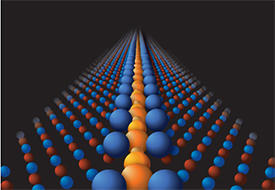

02/27/2012

© 2012 Ikuhara Group
Structural defects play a crucial role in determining the physical and electronic properties of materials, and understanding the nature of these defects is of key importance in correlating the properties of materials with their structure at the atomic level. A thorough understanding of structural defects requires a precise determination of their three-dimensional structure and chemical composition. In polycrystalline materials, this goal is complicated by difficulties in investigating defects occurring at the boundary between adjacent crystals. Now, Zhongchang Wang and Yuichi Ikuhara from the WPI-AIMR and other researchers have developed a method for investigating structural defects using a combination of advanced electron microscopy, spectroscopy and first-principles calculations1.
“Natural materials are often polycrystalline and their properties are determined by grain boundaries,” explains Ikuhara. Grain boundaries — the interface between two crystallite domains or ‘grains’ — trap atomic defects such as impurities and vacancies which can induce complex structural changes. However, it is difficult to elucidate the distribution and role of self-trapped grain boundary defects because of their very low concentration, and the lack of chemical information obtained from conventional electron microscopy methods.
To overcome these difficulties, the researchers devised a methodology that combines different scanning transmission electron microscopy techniques, electron energy-loss spectroscopy and high-precision density functional calculations. Furthermore, special care was taken to design an environment for the electron microscope that is free from mechanical vibrations and magnetic fields.
Wang, Ikuhara and colleagues applied the methodology on magnesium oxide, a technologically important material that has been studied for decades, but for which the atomic-scale grain boundary structure has remained unknown. To allow the controlled study of individual grain boundaries, the researchers fabricated a ‘bicrystal’ consisting of two crystals cut along different crystallographic directions which are joined at their surfaces.
Electron energy loss spectroscopy and transmission electron microscopy measurements revealed that titanium and calcium impurities segregate into the grain boundary. More importantly, these impurities interdisperse into the columns of magnesium oxide atoms, giving rise to a periodic superstructure along an atomically-straight boundary (see image). Comparing the experimental results with the results of the calculations, the researchers were able to pinpoint the structural transformation leading to a stable defect configuration. The analysis further showed that the calcium and titanium are bonded to the oxygen rather than the magnesium atoms.
“This method could in principle be applied to many types of defects in many systems,” says Wang. “The main advantage is that the combination of techniques allows extraction of atomic-scale information on point defects in defective regions, and provides insight into the structure-property interplay at the quantum level.”
Wang, Z., Saito, M., McKenna, K. P., Gu, L., Tsukimoto, S., Shluger, A. L. & Ikuhara, Y. Atom-resolved imaging of ordered defect superstructures at individual grain boundaries. Nature 479, 380 (2011). | article
This research highlight has been approved by the authors of the original article and all information and data contained within has been provided by said authors.